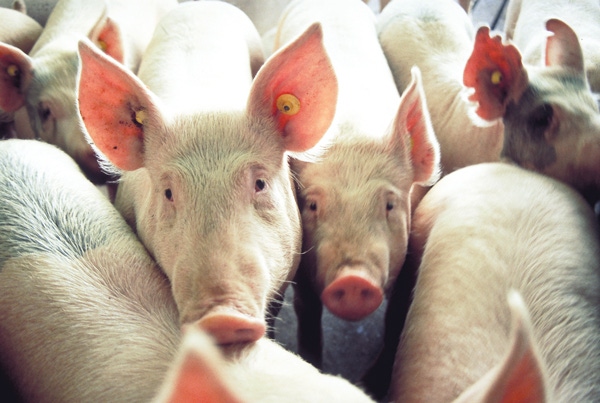A large trial was conducted to evaluate the growth rate, energy intakes and feed efficiency of pigs fed high- and low-density diets from 60 to 310 lb. and to compare metabolizable energy (ME) to net energy (NE) as a predictor of pig performance.
December 15, 2012

A large trial was conducted to evaluate the growth rate, energy intakes and feed efficiency of pigs fed high- and low-density diets from 60 to 310 lb. and to compare metabolizable energy (ME) to net energy (NE) as a predictor of pig performance.
The experiment included four sire lines, barrows (2,192) and gilts (2,280), two dietary energy densities and a light or heavy target body weight (260 and 290 lb. in replicates 1 to 6; 280 and 310 lb. in replicates 7 to 10).
Pigs were allocated to a series of low-energy (LE), corn-soybean meal-based diets (3.27 Mcal ME/kg) with 16% wheat midds or high-energy diets (HE) with 4.5 to 4.95% choice white grease (3.53 to 3.55 Mcal ME/kg). All diets contained 6% distiller’s dried grains with soluble (DDGS).
The HE and LE diets of each of the four phases were formulated to have equal lysine:Mcal ME ratios. Housed 11 or 12/pen, pigs were weighed and pen feed intake was recorded at 28-day intervals. Barrow and gilt daily feed intake (DFI) and ME and NE intake data were fitted to functions of body weight.
Pigs fed LE diets had lower average daily gain (ADG) than pigs fed HE diets (2.02 vs. 2.08 lb./day). Overall, DFI was greater for pigs fed the LE diets (5.78 vs. 5.40 lb. /day). However, no diet differences were observed for daily ME intake (8.76 vs. 8.78 Mcal/day) or NE intake (6.39 vs. 6.44 Mcal/day), thereby indicating that the pigs compensated for the decreased energy content of the LE diet.
Overall, gain/feed (0.362 vs. 0.377) and ADG/Mcal ME intake (0.109 vs. 0.113) was less for pigs fed LE compared to those fed HE diets. Pigs fed HE diets had 3.6% greater ADG:Mcal ME intake above maintenance and only 1.3% greater ADG:Mcal NE intake (0.152 vs. 0.150). Therefore, NE intake is a more accurate predictor of growth and gain/feed than ME intake. The concentrations of essential amino acids and minerals should be formulated, when possible, relative to the NE content of the diets.
Carcass composition was affected by the diets. Pigs fed the LE diets were leaner with less backfat depth, greater boneless ham and loin muscle weights and lesser belly weights than pigs fed the HE diets.
This trial shows that NE intake is a better predictor of pig performance than ME or DFI. However, the pigs fed the LE diets were leaner and would have been expected to have 3.3% greater gain above maintenance than the pigs feed the high-energy diets. This indicates that perhaps maintenance requirements were increased for the pigs fed the LE diets.
Although NE is currently the best predictor of pig performance, the pigs fed the LE diets were leaner and deposited less energy in their carcasses than pigs fed the HE diets. Energy flow models, taking into account the use of each source of energy to maintenance, lean growth and fat deposition may be needed to more closely predict pig performance.
Generally, the industry trend is toward feeding diets that are lower in energy and greater in fiber content. Pigs will consume more of the LE diets but, based on NE system, will have less energy available for growth. This will result in pigs growing slower, but remaining leaner than pigs fed the higher energy diets more commonly used in the past. Feed budgets should be based on the pigs’ NE intakes and feed efficiency adjusted for the NE concentration of the diets fed.
It should be noted that the economic impact of reduced growth rates and increased leanness of the LE diets will be producer-specific and may vary by season. A pork producer’s marketing schedule and payment for predicted carcass lean percentage will affect the cost-returns of the changes in pig performance as well.
To be able to formulate the most profitable series of diets, one must have and use the most accurate NE estimate of each feedstuff. Pricing and purchasing feedstuffs based on their NE and formulating diet nutrient concentrations based on NE vs. ME could increase profitability by $3 to $5/head.
Researchers: A. P. Schinckel, Purdue University, West Lafayette, IN; M.E. Einstein, S. Jungst, J.O. Matthews, B. Fields, C. Booher, T. Dreadin, A. Sosnicki, and E. Wilson, PIC North America, Hendersonville, TN; C. Fralick, Swine Tek, Convoy, OH; and S. Tabor and R. D. Boyd, The Hanor Company, Franklin, KY. Contact Schinckel by phone (765) 494-4836 or e-mail [email protected].
You May Also Like



